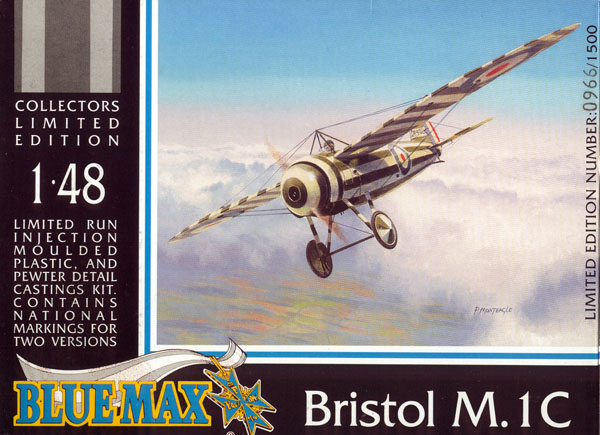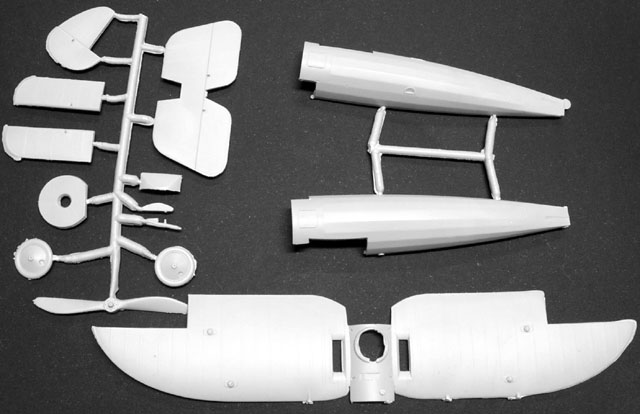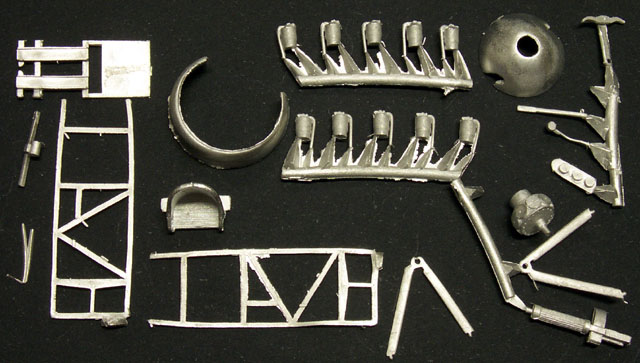|
Bristol
M.1C Monoplane

Blue
Max

Blue
Max's 1/48 scale Bristol M.1C is available
online at Squadron.com
S
u m m a r y
|
| Catalogue Number: |
BM115 |
| Scale: |
1/48 |
| Contents and Media: |
14 parts in short-run injection
moulded styrene; 26 parts in pewter (white metal); 7 lengths of fine steel
rod. |
| Price: |
USD$41.96 from
Squadron.com |
| Review Type: |
First Look |
| Advantages: |
Good detail, nice fabric texture;
high-quality plastic; delicately detailed pewter parts; otherwise neglected subject; interesting marking
options; minimal rigging; attractive packaging and boxart. |
| Disadvantages: |
Some short-run attributes; modelling
skills required; additional references will be helpful; no rigging
diagram; enhancement of
details will be required in the cockpit. |
| Recommendation: |
Recommended |
Reviewed by
Brett Green
I bought my first Blue Max kit in 1991. It was the 1/48 scale Junkers J-9,
and I was impressed initially by the lines of the chunky corrugated metal
monoplane, then by the striking boxart. Indeed, the design of the packaging was,
in my opinion, perhaps the most attractive I had seen. The combined effect was
sufficient to help me part with the princely sum of $40 despite my lack of
experience in WWI modelling.
Ten years down the track, Chris Gannon of Blue Max has released another
chunky monoplane. The design of the packaging has lost none of its appeal in the
ensuing decade, but the standard of the contents has made some progress.
Blue Max's 1/48 scale Bristol M1.C monoplane is an unashamedly limited run
product.

The 14 plastic parts exhibit some flash, and the sprue attachment points to
the smaller parts are relatively thick. However, the quality of the plastic is
first-rate, the structural details such as access hatches, footstep and rigging
attachment points are crisply rendered, and the surface texture (in particular
the ribbing tape) is very subtle and authentic. Rigging points are
thoughtfully indicated by tiny indentations. The short-run origins of the kit
are only betrayed by the slightly thick trailing edges on the wing, and fading
rib tape detail on one section of the lower wing.
The fuselage is detailed on the outside and the inside. The inner sidewalls
feature moulded-on structural detail. The wing is supplied as a full-span,
single part with detail top and bottom, greatly simplifying assembly and
alignment.. This is a major advance on earlier Blue Max efforts (although my
Fokker did feature Chris Gannon's autograph - and fingerprints - on the lumpy
inside surface of the fuselage!).

This brand remains committed to white metal detail parts in this age of
resin. The 26 pewter parts are a joy to behold. The detail of the seat, the
Vickers machine gun and the ten engine cylinders rivals resin, and the
flexibility of the metal media will come in very handy for the wheel braces and
the cockpit framework. All the cockpit components are white metal, including the
small vertical instrument panel. A sharp knife will make short work of the thin
flash surrounding most parts. Extra detail for the instruments should be added
to the blank, raised dial faces.
Seven lengths of steel rod are supplied for the undercarriage braces/axle and
the rigging tower on top of the fuselage. Some care will be required in gluing
these parts.
 Markings
are supplied for two aircraft - a garishly striped trainer and an operational
machine based in Salonika finished in PC10 and Azure Blue. Markings
are supplied for two aircraft - a garishly striped trainer and an operational
machine based in Salonika finished in PC10 and Azure Blue.
The instructions are brief. Seven small detail photos and a single
exploded-view diagram are supplied. There is no rigging diagram. Blue Max
clearly expects that its clients know what they are doing! By contrast,
colouring notes are quite comprehensive, with cross references to Federal
Standards, Methuen and Xtracolour provided. Even so, for a totally authentic kit
I would recommend that the instructions' advice is followed by adding the
Windsock Datafile on the Bristol M.1C to your reference collection.
.
It is pleasing to see such a significant but neglected WWI aircraft available in
1/48 scale.
Blue Max's 1/48 scale Bristol M.1C provides all the basic components to build an
accurate and impressive model. Modelling skills will be required to clean-up,
align and detail the parts, but a little extra effort should produce a
showstopper.
Recommended to experienced WWI modellers.
Review and Images Copyright © 2001 by Brett
Green
Page Created 07 December, 2001
Last updated 22 July, 2003
Back to HyperScale Main Page
Back to Reviews Page
|
Home | What's
New | Features
| Gallery |
Reviews | Reference
| Forum
| Search